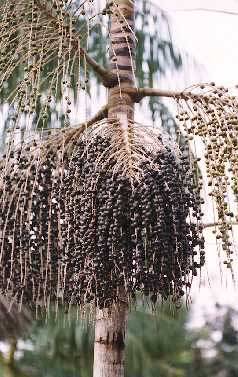Euterpe oleraceae
Açaí is a multi-stemmed palm native to eastern Amazonia, with the greatest occurrence in the estuary of the Amazon River, where it occupies most of the floodplain forest of the region. The palm is also found in the Brazilian states of Amapá, Amazonas and Maranhão, as well as in Guyana, French Guiana and Venezuela. Açaí palms grow at various densities in both seasonally flooded forests and permanently flooded forests. The açaí fruit grows best in open areas with substantial sun, such as floodplain forests where canopy trees have been thinned. The palms can reach a height of over 25 m, with trunks between 9 cm and 16 cm in diameter. The palms generally grow with 4?9 stems per clump, but up to 25 stems is possible.
Uses of Açaí
Fruit: Açaí fruit is sold as frozen pulp, jam and juice. It is used to flavour ice cream and other frozen treats, cakes, porridges and bonbons. It is also sold as powder and pigments. Palm hearts: The palm hearts are eaten fresh or canned.
Leaves: The leaves are constructed into houses, baskets, carpets, fans and ropes for climbing trees. They also provide fertilizer and animal feed. The spathe that covers the fruit bunch can be taken by children to make toy boats or utilized by parents to make hammocks for babies.
Seed: The seeds make excellent fertilizer and, when dry, are crafted into jewellery.
Trunk: The trunks are used for framing in the construction of rural houses and to make bridges across small streams.
Young roots: When made into a medicinal tea, the young roots help to get rid of worms.
Fruit stem: The stem remaining after the fruit are removed is used as a fertilizer or as a garden broom. When burned, the stem serves as an insect repellent.

